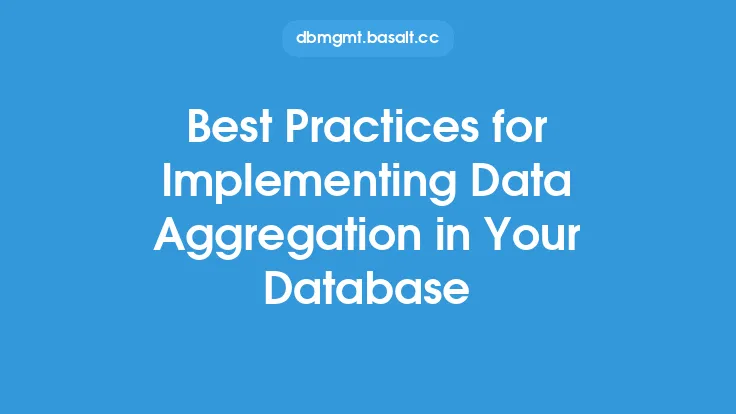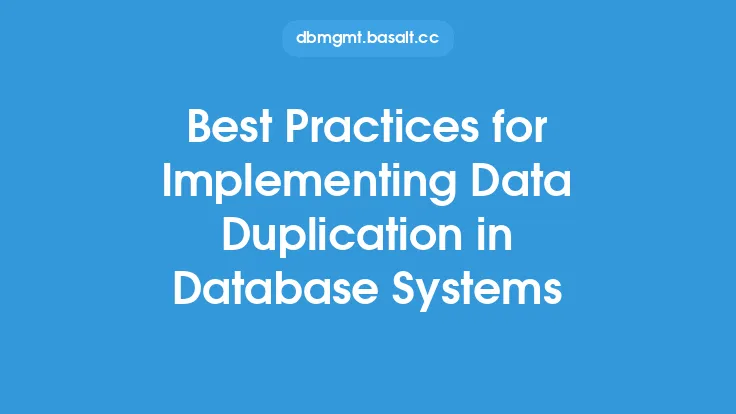When designing a database, it's essential to consider the overall management and oversight of the data it will store. This is where data governance comes into play, as it ensures that the data is accurate, reliable, and accessible to those who need it. Effective data governance is critical to the success of any organization, as it enables informed decision-making, reduces risk, and improves overall data quality. In this article, we'll explore the best practices for data governance in database design, providing a comprehensive guide for database administrators, data architects, and other stakeholders.
Introduction to Data Governance
Data governance refers to the set of policies, procedures, and standards that govern the management of data within an organization. It encompasses a broad range of activities, including data quality, data security, data retention, and data access control. The primary goal of data governance is to ensure that data is managed in a way that supports the organization's overall mission and objectives. This involves establishing clear roles and responsibilities, defining data standards and policies, and implementing processes for monitoring and enforcing compliance.
Data Governance Framework
A data governance framework provides a structured approach to managing data governance activities. It typically consists of several components, including:
- Data governance policies: These define the rules and guidelines for managing data within the organization.
- Data governance procedures: These outline the steps to be taken in order to implement data governance policies.
- Data governance standards: These establish the criteria for data quality, data security, and other aspects of data management.
- Data governance metrics: These provide a way to measure the effectiveness of data governance activities.
A well-designed data governance framework is essential for ensuring that data is managed consistently and effectively across the organization.
Data Quality Considerations
Data quality is a critical aspect of data governance, as it directly impacts the accuracy and reliability of the data. There are several key considerations when it comes to data quality, including:
- Data accuracy: This refers to the degree to which the data is correct and free from errors.
- Data completeness: This refers to the degree to which the data is comprehensive and includes all necessary information.
- Data consistency: This refers to the degree to which the data is consistent across different systems and applications.
- Data timeliness: This refers to the degree to which the data is up-to-date and reflects current information.
To ensure high data quality, it's essential to implement data validation and data cleansing processes, as well as to establish data quality metrics and monitoring procedures.
Data Security Considerations
Data security is another critical aspect of data governance, as it protects the data from unauthorized access, theft, or damage. There are several key considerations when it comes to data security, including:
- Access control: This refers to the mechanisms for controlling who can access the data and what actions they can perform.
- Authentication: This refers to the mechanisms for verifying the identity of users and ensuring that they are authorized to access the data.
- Encryption: This refers to the mechanisms for protecting the data from unauthorized access by encrypting it.
- Backup and recovery: This refers to the mechanisms for ensuring that the data can be recovered in the event of a disaster or system failure.
To ensure high data security, it's essential to implement robust access controls, authentication mechanisms, and encryption protocols, as well as to establish backup and recovery procedures.
Data Governance Tools and Technologies
There are several tools and technologies that can support data governance activities, including:
- Data governance software: This provides a centralized platform for managing data governance policies, procedures, and standards.
- Data quality tools: This provides a way to monitor and improve data quality, including data validation and data cleansing.
- Data security tools: This provides a way to protect the data from unauthorized access, including access control, authentication, and encryption.
- Data analytics tools: This provides a way to analyze and visualize the data, including data mining and business intelligence.
To get the most out of these tools and technologies, it's essential to carefully evaluate and select the ones that best meet the organization's needs.
Implementing Data Governance
Implementing data governance requires a structured approach, including:
- Establishing clear roles and responsibilities: This includes defining the roles and responsibilities of data governance stakeholders, including data owners, data stewards, and data users.
- Defining data governance policies and procedures: This includes establishing clear policies and procedures for managing data governance activities.
- Implementing data governance standards: This includes establishing clear standards for data quality, data security, and other aspects of data management.
- Monitoring and enforcing compliance: This includes establishing processes for monitoring and enforcing compliance with data governance policies and procedures.
To ensure successful implementation, it's essential to communicate clearly with stakeholders, provide training and support, and continuously monitor and evaluate the effectiveness of data governance activities.
Best Practices for Data Governance
There are several best practices for data governance that can help ensure its success, including:
- Establishing a data governance council: This provides a forum for stakeholders to discuss and address data governance issues.
- Defining clear data governance policies and procedures: This provides a foundation for managing data governance activities.
- Implementing data quality and data security controls: This helps to ensure the accuracy, reliability, and security of the data.
- Providing training and support: This helps to ensure that stakeholders have the necessary skills and knowledge to manage data governance activities.
- Continuously monitoring and evaluating: This helps to ensure that data governance activities are effective and aligned with the organization's overall mission and objectives.
By following these best practices, organizations can establish a robust data governance framework that supports informed decision-making, reduces risk, and improves overall data quality.
Conclusion
Data governance is a critical aspect of database design, as it ensures that the data is accurate, reliable, and accessible to those who need it. By following the best practices outlined in this article, organizations can establish a robust data governance framework that supports informed decision-making, reduces risk, and improves overall data quality. Whether you're a database administrator, data architect, or other stakeholder, this article has provided a comprehensive guide to the key considerations and best practices for data governance in database design.





